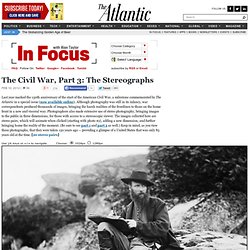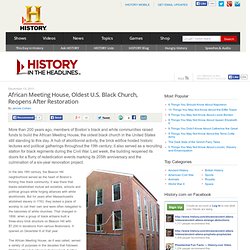

Voices of History - Old Time Radio Shows. Michael Johnson, USA. History Of Video Games In Less Than 3 Minutes. Stone-age Europeans were the first to set foot on North America. In a discovery that could rewrite the history of the Americas, archaeologists have found a number of stone tools dating back between 19,000 and 26,000 years, and bearing remarkable similarities to those made in Europe.

Adding to the weight of evidence is fresh analysis of stone knife unearthed in the US in 1971 that revealed it was made of French flint. Professor Dennis Stanford from Washington's Smithsonian Institution, and Professor Bruce Bradley from Exeter University believe that the ancient Europeans travelled to North America across an Atlantic frozen over by the Ice Age. During the height of the Ice Age, ice covered some three million square miles of the North Atlantic, providing a solid bridge between the two continents. Plentiful numbers of seal, penguins, seabirds and the now extinct great auk on the edge of the ice shelf could have provided the stone-age nomads with enough food to sustain them on their 1,500-mile walk. The machines that made the Jet Age. This is a companion piece to Iron Giant: One of America’s great machines comes back to life, a feature by Tim published in The Atlantic Germany, June 1945.

The Nazi regime has been toppled; the war in Europe is over. But the Allied victory is largely the result of sheer overwhelming force, not technological superiority — and the victors know it. Most glaringly, while the Allies still rely on propeller-driven aircraft, the Luftwaffe has put three jets successfully into service. A Messerschmitt Me 262, the first military jet to enter service. A Boeing B-29, the first bomber with pressurized crew compartments. The reasons for German air superiority were several, of course, but a key one was their mastery of light-metal forging.
Not surprisingly, after Germany surrendered, both the U.S. and the USSR sought to take control of its forging facilities. Burgonet - StumbleUpon. The Civil War, Part 3: The Stereographs - In Focus. Last year marked the 150th anniversary of the start of the American Civil War, a milestone commemorated by The Atlantic in a special issue (now available online).

Although photography was still in its infancy, war correspondents produced thousands of images, bringing the harsh realities of the frontlines to those on the home front in a new and visceral way. Photographers also made extensive use of stereo photography, bringing images to the public in three dimensions, for those with access to a stereoscopic viewer. The images collected here are stereo pairs, which will animate when clicked (starting with photo #2), adding a new dimension, and further bringing home the reality of the moment. (Be sure to see part 1 and part 2 as well.) Keep in mind, as you view these photographs, that they were taken 150 years ago -- providing a glimpse of a United States that was only 85 years old at the time. [20 stereo pairs] Use j/k keys or ←/→ to navigate Choose: Photographer Timothy H. African Meeting House, Oldest U.S. Black Church, Reopens After Restoration. Jennie Cohen More than 200 years ago, members of Boston’s black and white communities raised funds to build the African Meeting House, the oldest black church in the United States still standing to this day.

A hub of abolitionist activity, the brick edifice hosted historic lectures and political gatherings throughout the 19th century; it also served as a recruiting station for black regiments during the Civil War. Last week, the building reopened its doors for a flurry of rededication events marking its 205th anniversary and the culmination of a six-year renovation project. Boston’s African Meeting House, where abolitionists like Frederick Douglass once spoke out against slavery, underwent meticulous renovations designed to replicate the historic building’s 1855 appearance.